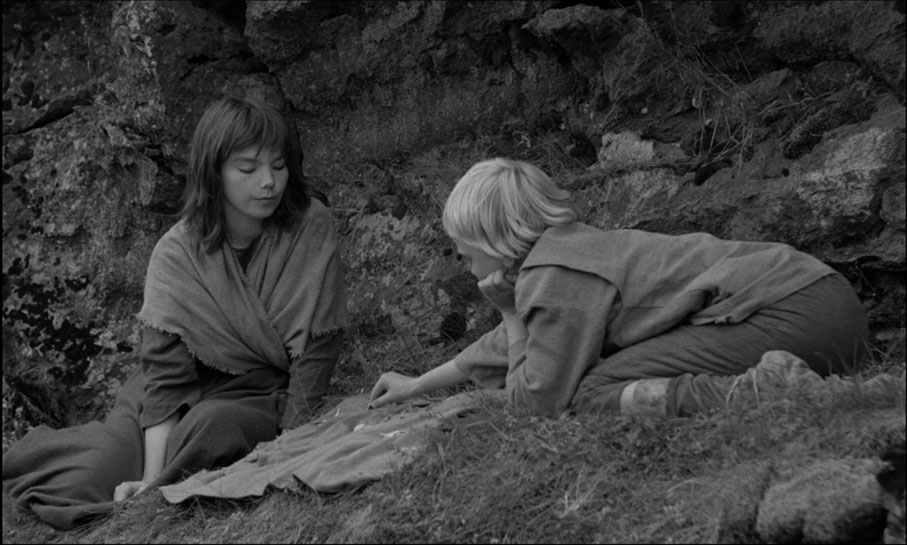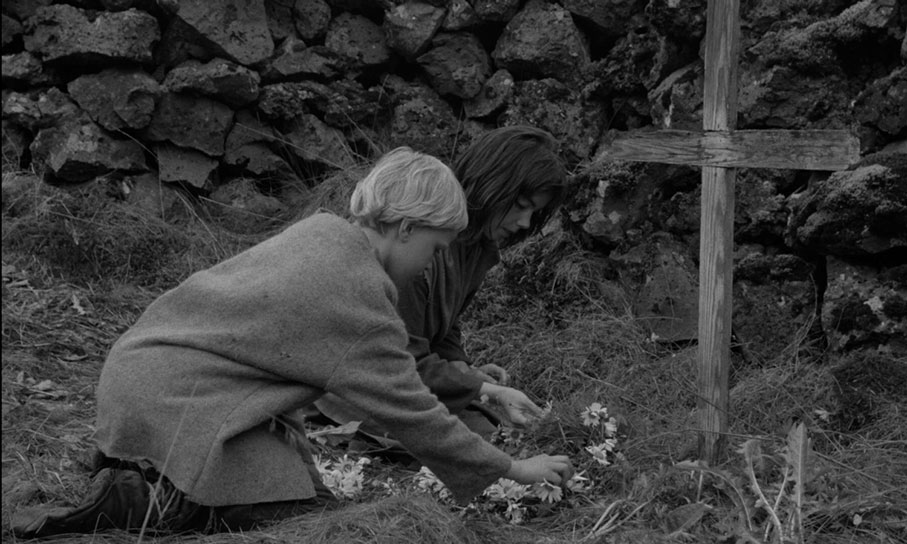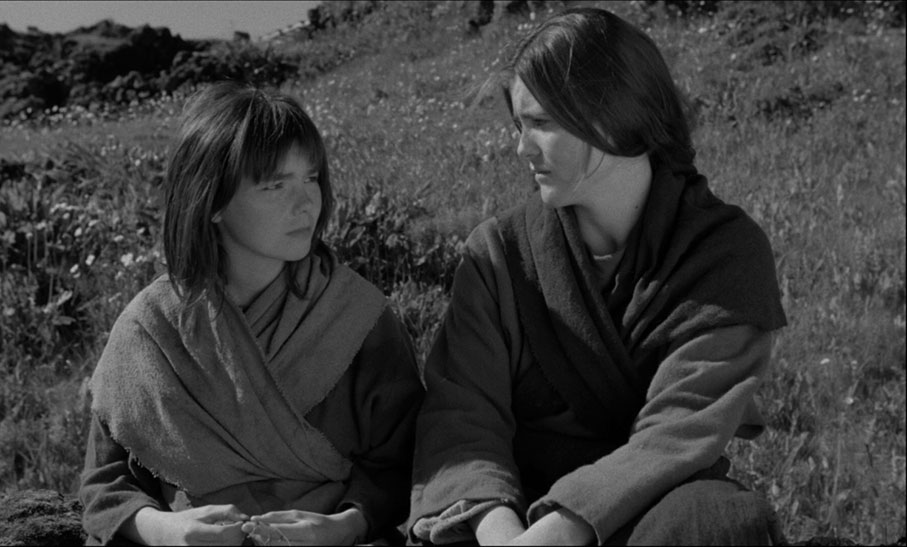|
Iceland, at some unspecified time in the Middle Ages. Margit (Björk Guðmundsdóttir, uniquely billed under her full name) and her older sister Katla's (Bryndis Petra Bragadóttir) mother is burned for witchcraft. The two sisters escape to somewhere where no one knows them, and meet a young widower, Jóhann (Valdimir Örn Flygenring), who lives with his son Jónas (Geirlaug Sunna Þormar, actually a girl playing a boy). Katla casts a spell to make Jóhann fall in love with her, and they begin to live together. Margit and Jónas become friends, but he doesn't accept Katla as his stepmother...
It's often the case with a director or actor, that a film of theirs makes such an impact that many people assume that it's their debut, overlooking an earlier film which didn't exactly set the world alight. (For example, Whiplash and Muriel's Wedding were actually the second features of Damian Chazelle and P.J. Hogan respectively, and The Sixth Sense was M. Night Shyamalan's third. Similarly, My Brilliant Career was not Judy Davis's first film but her second.) Björk won Best Actress at Cannes in 2000 for Dancer in the Dark, and many assume that that was her first acting role, and her only cinema feature until The Northman in 2022. However, it wasn't. Leaving out an uncredited appearance in Prêt-à-Porter (1994), her actual debut was in The Juniper Tree, released in 1989 but shot two years earlier.

The Juniper Tree was written and directed by Nietzchka Keene, based on one of the Brothers Grimm's most gruesome (and arguably misogynistic) fairy tales. The title also appears in the lines from T.S. Eliot's Ash Wednesday, which the film uses as an epigraph. The financing was raised entirely by Keene, who had followed an undergraduate degree in Germanic Linguistics with a Masters in film production. While there, she made short films, three of which are on this disc as extras. She spent a year in Iceland on a Fulbright Scholarship and wrote the script for The Juniper Tree there, returning in 1987 to shoot the film. The film was shot almost entirely on location there, with some pick-up shots being done in the USA. Interiors were largely shot in rooms hired from museums.
Due to financial problems, the film was not completed until 1989, and premiered the following year. It attracted little attention until 2019 (fifteen years after Keene's death, from pancreatic cancer at the age of fifty-two), when it was restored, and not just because its lead actress was much more famous then than she had been at the time the film was released. She had still been a member of The Sugarcubes at the time, and her solo career was to begin three years later with the album Debut. At this time a performer but not an actress, Björk gives a fine performance, able to convincingly play younger than she actually was. Margit is about fourteen, though Björk was actually twenty-one, and had recently had a son, whom she nursed on set in between takes.
The Juniper Tree is a slow-burning film, visually striking (shot in 35mm on black and white stock, something of a rarity then, let alone now when black and white films are more often shot on colour stock or, nowadays, digitally, and post-produced into monochrome) and nicely acted by its cast of five, all Icelanders in this English-language film. Keene clearly has an eye, and it's a pity that she was only able to make two more feature films, one of them for television.
The Juniper Tree is released on Blu-ray by the BFI on a single disc encoded for Region B only. The film itself has a 15 certificate, while from the extras Hinterland has a 12 and The Witch's Fiddle a U. The remaining short films don't appear on the BBFC website at the time of writing, and Iceland: The Land of Ice and Fire is likely exempted as a documentary.

The film was shot in 35mm black and white, and the Blu-ray transfer is based on a 4K restoration and is presented in the intended ratio of 1.66:1. As I say above, the film was shot on actual black and white stock, rather than colour stock, and you can tell the difference. Blacks, whites and greys seem accurate, both in the exteriors and the use of chiaroscuro in the interiors. Grain is natural and filmlike.
The end credits say that The Juniper Tree was released with a Dolby SR sound mix, which is presumably the source of the LPCM 2.0 track here, which is in mono. Dialogue, sound effects and music are well balanced, with some of the latter becoming quite loud. Subtitles for the hard-of-hearing are available on the feature only.
Commentary by Dr Guðrun D. Whitehead
Newly recorded for this release, this is a dense commentary in which Dr Whitehead discusses the historical background of the film, and the use of myths and folklore, and is much less scene-specific than many commentaries. A worthwhile track that needs attention paid to it.
Still (4:04)
The disc contains three short films by Nietzchka Keene, beginning with this one, the earliest, from 1978. Shot in grainy black and white 16mm, with a mute soundtrack, it's a brief experimental piece, exploring a female gaze in cinema, with mirrors playing a part.
Hinterland (24:50)
From 1981, made as a student film (in colour 16mm), Hinterland is a more conventional narrative than the other two shorts on this disc. An orphaned young girl is passed on to a reclusive old woman to stay, given that she is the girl's only known relative. Events proceed to a dark conclusion.
Aves (6:56)
A later short, from 1998, finds Keene in experimental mode again, in this film made from animated stills, with images of birds (hence the title) overlaid over religious iconography, with the cast of one (Tinka Menkes) appearing as a nun.

Interview with Nietzchka Keene (14:44)
An archival interview from 2002. She talks about her inspiration from the Grimm fairy tale, which in the original featured a mother and daughter, which she changed to older and younger sisters. The project was not the one she went to Iceland on her scholarship, but the cast and crew thought that the new project was suitably Icelandic. Keene talks about her interest in witchcraft and its implications for women in this medieval society, and describes the production. She had considered Björk for the role of Margit, but had passed due to her being pregnant. A younger actress hadn't worked out, and by then Björk had given birth, so she was cast.
Outtakes (4:30)
As it says, mostly silent, but with clapperboards on screen, indicating that the shots were filmed MOS (i.e. silent, with the sound to be added later). Nietzchka Keene adds some brief commentary.
Interview with Randy Sellars (28:41)
This is a newer (2019) interview with the film's cinematographer. When he was hired to shoot The Juniper Tree, he had forgotten that he had worked with Nietzchka Keene before, on Hinterland as a camera assistant. He talks about his and Keene's aesthetic approach to the film, drawing on the works of Dreyer and the black and white films of Ingmar Bergman, and the importance of contrast in black and white. In the interior scenes, their use of chiaroscuro was intended to evoke the old masters such as Caravaggio. The Arctic Circle crosses Iceland, so at the time of shooting, the sun was up twenty-three hours a day, resulting in problems sleeping. Another disadvantage of their remote location was that the film had to be shipped back to the USA for processing, so they were unable to see rushes and had to trust that nothing had gone wrong.
The Witch's Fiddle (7:03)
Made in 1924, this was an amateur production by the Cambridge University Kinema Club. (If you own the BFI Flipside release of Legend of the Witches/Secret Rites, this film is an extra there too.) A short tale of an enchanted musical instrument given to a young man by the witch of the title, this is an engaging short, transferred to Blu-ray from what is clearly a very battered source.
Iceland: The Land of Ice and Fire (21:43)
This is an education film from 1929, again silent, intended for schools. Animated sequences explain Iceland's geography and climate, and live action footage includes shots of the national games in Reykjavik and women singing.

US restoration trailer (1:44)
Booklet
The BFI's booklet, available in the first pressing only, runs to twenty-eight pages. It begins with an essay by Dr Deborah Allison, "Picking the Bones out of the Adult Fairytale Film", which begins by reminding us that the darker aspects of fairytales were there from the start – Disney's Snow White originally went out with an A certificate in the UK and Margaret Hamilton's witch in The Wizard of Oz has scared generations of children witless. But nowadays, fairytale reworkings for adults are not uncommon, and The Juniper Tree was a little ahead of its time in that respect. Even so, Allison identifies predecessors: Cocteau's take on Beauty and the Beast, and Powell and Pressburger's on The Red Shoes, not forgetting Neil Jordan's and Angela Carter's The Company of Wolves. Allison goes on to look at the Brothers Grimm story which underpins Nietzchka Keene's film, and also talks about Barbara Comyns's novel based on the same story, which was published in 1985 while Keene was working on the film. The rediscovery of The Juniper Tree following its restoration now ties it in with the current interest in folk horror.
Next up is a review of the film by Angeline Gragasin, reprinted from Screen Slate in 2019, then a two-page reminiscence by associate producer Patrick Moyroud, and a profile of Nietzchka Keene by Amy Sloper. These two pieces first appeared in the US Blu-ray release from Arbelos. Paul Fairclough contributes a four-page profile of Björk. Also in the booklet are film credits, notes on and credits for the extras, restoration and transfer notes, and stills.
|